IABSE Young Engineers Colloquium in East Asia
Final Program
2018-10-09
1. Organizers
Organized by: The Chinese Group of IABSE
The Japanese Group of IABSE
The Korean Group of IABSE
Tongji University
State Key Lab for Disaster Reduction in Civil Engineering
2. Dates and Venue
October 24 (Wed) and 25 (Thu), 2018
Lecture Hall (1st Floor), Bridge Building, Tongji University
1239 Siping Rd., Shanghai 200092, China
3. Background
This IABSE Young Engineers Colloquium from East Asia (China, Japan and Korea) offers young engineers the opportunity to present interesting researches, projects or construction practice to an audience of fellow structural engineers and researchers. A prominent specialist on structural engineering will make a keynote lecture. Technical tours will be arranged in Shanghai.
4. Program
Keynote Lecture (Oct. 24, Wed.):
Mr. Naeem Ullah Hussain, Director/Global Bridge Leader, Ove Arup & Partners Hong Kong Ltd.
Technical Sessions (Oct. 24, Wed.):
A total of 22 presentations of research papers and technical reports of construction project.
Technical Tour (Oct. 25, Thu.):
A half-day visit to four places of interests in Shanghai: Wind Tunnel Lab of SLDRCE, Tongji University Museum, The Bund, and Boat Tour for bridges over Huangpu River.
Co-Chairs: Yaojun Ge, Tongji University, China
Yozo Fujino,Yokohama National University, Japan
Ho-Kyung Kim, Seoul National University, Korea
Secretory: Ye Xia, Tongji University, China
Members: Eui-Seung Hwang, Kyung Hee University, Korea
Hiroshi Katsuchi,Yokohama National University,Japan
Hyun-Moo Koh, Seoul National University, Korea
Shunichi Nakamura, Tokai University, Japan
Yoshiaki Okui, Saitama University, Japan
James Shin, Cable Bridge Co. Ltd, Korea
Limin Sun, Tongji University, China
Dong Xu, Tongji University, China
6. Schedule Overview
Time | Technical Program |
October 24 (Wed) | Sessions |
08:30-8:45 | Opening Ceremony |
08:45-9:45 | Keynote Lecture |
09:45-10:15 | Coffee Break, Group Photo |
10:15-11:55 | Technical Sessions (Part I) |
11:55-13:30 | Lunch at Sanhao Dock |
13:30-15:00 | Technical Sessions (Part II) |
15:00-15:30 | Coffee Break |
15:30-17:00 | Technical Sessions (Part III) |
17:00-17:30 | Walk to Jinjiang Metropolo Hotel (15thFloor) |
17:30-19:30 | Closing Ceremony, Awarding Ceremony, Dinner |
October 25 (Thurs) 08:30-13:00 | Technical Tour |
7. Best Paper Award
Presentations will be evaluated and the best 3 speakers will be granted the Outstanding Young Engineer Best Paper Award with 2000RMB reward for each.
8. Registration and Contacts
Young engineers in any country can make presentations. Not only young engineers but also senior engineers can participate in this colloquium and are welcome for discussions and giving advice to young engineers. Please register by e-mail at iabse-jpn@jssc.or.jp (Japan) or kibse@kibse.or.kr (Korea) or yxia@tongji.edu.cn (China and other countries).
Registration fee for Colloquium: 500 RMB.
Official website:http://shmc.tongji.edu.cn/iabse
Contacts
Mr. Yixian Li, Program & Technical Tour, Tel: 86+17317801842, yixian_li9504@163.com
Ms. Yan Wu, Registration & Invoice, Tel: +86-21-65980952, bridge-SHM@tongji.edu.cn
Dr. Ye Xia, General Affairs, Tel: +86-21-65985130, yxia@tongji.edu.cn
The template of paper is in the bottom of the webpage.
Transportation
From Airport to Kingswell Hotel
[1]. From Hongqiao Airport, take Metro Line 10, to Tongji University Station, Exit 1. Walk to the hotel. 50 minutes. 5 RMB.
[2]. From Purdong Airport, take Metro Line 2, to East Nanjing Road Station. Transfer Line 10 to Tongji University Station, Exit 1. 80 minutes. 7 RMB.
[3]. Taxi. Show taxi driver the address: Kingswell Hotel同济君禧大酒店,杨浦区彰武路50号. 40 minutes & 100 RMB from Hongqiao Airport. 50 minutes & 170 RMB from Pudong Airport.
From Airport to Jinjiang Metropolo Hotel
[1]. From Hongqiao Airport, take Metro Line 10, to Tongji University Station, Exit 5. Walk to the hotel. 50 minutes. 5 RMB.
[2]. From Purdong Airport, take Metro Line 2, to East Nanjing Road Station. Transfer Line 10 to Tongji University Station, Exit 5. 80 minutes. 7 RMB.
[3]. Taxi. Show taxi driver the address: Jinjiang Metropolo Hotel上海锦江白玉兰宾馆,杨浦区四平路1251号. 40 minutes & 100 RMB from Hongqiao Airport. 50 minutes & 170 RMB from Pudong Airport.
From Hotels to the Venue
[1]. By walk according to the Campus map below. 15 min.
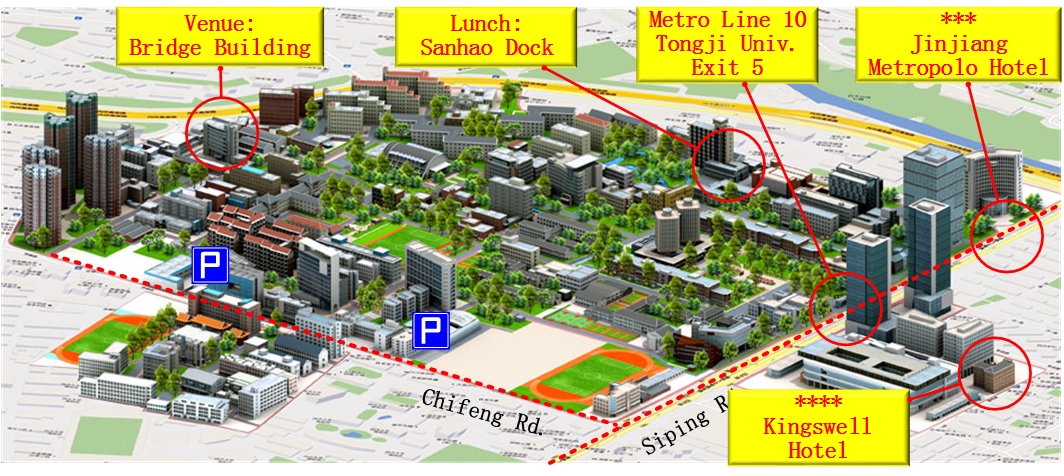
Fig. 1 Campus map
Accommodation
[1]. Kingswell Hotel, 4-Star, RMB500/night (Twin) or RMB588/night (Double), with Breakfast.
[2]. Jinjiang Metropolo Hotel, 3-Star, RMB480/night (Twin/Double), with Breakfast.
Weather at Shanghai
October 23 | 20~25℃ |
|
October 24 | 18~23℃ |
|
October 25 | 15~20℃ |
|
Detailed Technical Program
08:30-08:45 | Opening Ceremony | Lecture Hall Bridge Building | |
08:45-09:45 | Keynote Lecture | ||
Form and Function in Design of Bridges | Naeem Ullah Hussain | ARUP | |
09:45-10:15 | Coffee Break, Group Photo | ||
10:15-11:55 | Technical Sessions (Part I) | Chair | |
Yoshiaki Okui | |||
Field investigation of damaged bridges in 2016 Kumamoto Earthquake | Shuichi Fujikura | Utsunomiya University | |
Evaluation of ERW pipe structural performance considering manufacturing process | Seong-Wook Han | Seoul National University | |
Long term assessment and design of steel bridge -a copula approach | Yi Zhang | Tsinghua University | |
Structural design of the New National Stadium in Japan | Takahiro Kanno | Taisei Corperation | |
Construction of the stayed cable bridge, Samdo Bridge | Dong-Hyun Kim | COWI Korea | |
Design and construction of China-Maldives Friendship Bridge | Xinpeng You | Second Hurbor Engineering Company LTD. | |
Structural characteristics of multi-span cable-stayed bridges with hybrid towers | Yutaka Okamoto | Kawada Industry Corporation | |
Control of vortex-induced vibration of long-span bridges by using the Tuned Mass Damper Inerter | Kun Xu | Beijing University of Technology | |
11:55-13:30 | Lunch at Sanhao Dock | ||
13:30-15:00 | Technical Sessions (Part II) | Chair | |
Limin Sun | |||
Seismic retrofitting of rectangular bridge piers using Ultra-High Performance Fiber Reinforced Concrete jacket | Teng Tong | Southeast University | |
Technical report of long span pedestrian suspension bridge in Korea | Jeong-Kyoon An | CableBridge Co., Ltd. | |
Impact resistant behavior of steel fiber reinforced PFC beam strengthened with AFRP sheet | Yusuke Kurihashi | Muroran Institute of Technology | |
Vibration testing and damping identification of a long-span suspended footbridge | Doyun Hwang | Seoul National University | |
Experimental study of wave slamming loads on elevated pile cap of pile group foundation for sea-crossing bridges | Kai Wei | Southwest Jiaotong University | |
Push-out tests of perfobond strip with steel fiber reinforced mortar | Minh Hai Nguyen | Utsunomiya University | |
Experimental study on cable force measurement by cable frequency method | Yiqing Zou | OVM Technology Center | |
15:00-15:30 | Coffee Break | ||
15:30-17:00 | Technical Sessions (Part III) | Chair | |
Ho-Kyung Kim | |||
Reliability-based fatigue life evaluation of deteriorated steel structural members | Lee-Sak An | Seoul National University | |
Simulation of flow over complex terrain by coupling of WRF and LES | Haotian Dong | Tongji University | |
Basic study on torsional behavior of the box girder bridges subjected to thermal history due to fire | Yusuke Takahashi | Osaka Institute of Technology | |
Training general bridge damage detection deep net using inspection data base | Ji Dang | Saitama University | |
Numerical simulation of mechanical behavior of post-tension prestressed concrete beam with various bond condition of PC bar | Kenta Takeda | Nagoya Institute of Technology | |
The development technology of component-oriented analysis software for the bridge structure | Zilong Zhang | Tonghao Civil Engineering Consulting Co.Ltd. | |
Fracture Mechanics Based Fatigue Life Prediction Method for RC Slabs in a Punching Shear Failure Mode | Pengru Deng | Hokkaido University | |
NOTE: 10 min for each presentation followed by 20min Q&A in the end of each technical session.
Technical Tour
October 25 | Technical Tour |
08:30 | Gather at the Bridge Building |
08:30-09:00 | Visiting Wind Tunnel Laboratory [1] |
09:00-09:15 | Walking to Tongji University Museum |
09:15-10:00 | Visiting Tongji University Museum [2] |
10:00-10:30 | Taking Metro to the Bund [3] |
10:30-11:00 | Walking the Bund to the wharf |
11:00-12:00 | Sightseeing Boat Tour [4] * |
12:00-12:30 | Come Back to Tongji University by Metro Line 10 |
* The cost for transportation and boat tour is RMB 130 at participants' own cost, pay at registration. One can visit only the tunnel and museum for free.
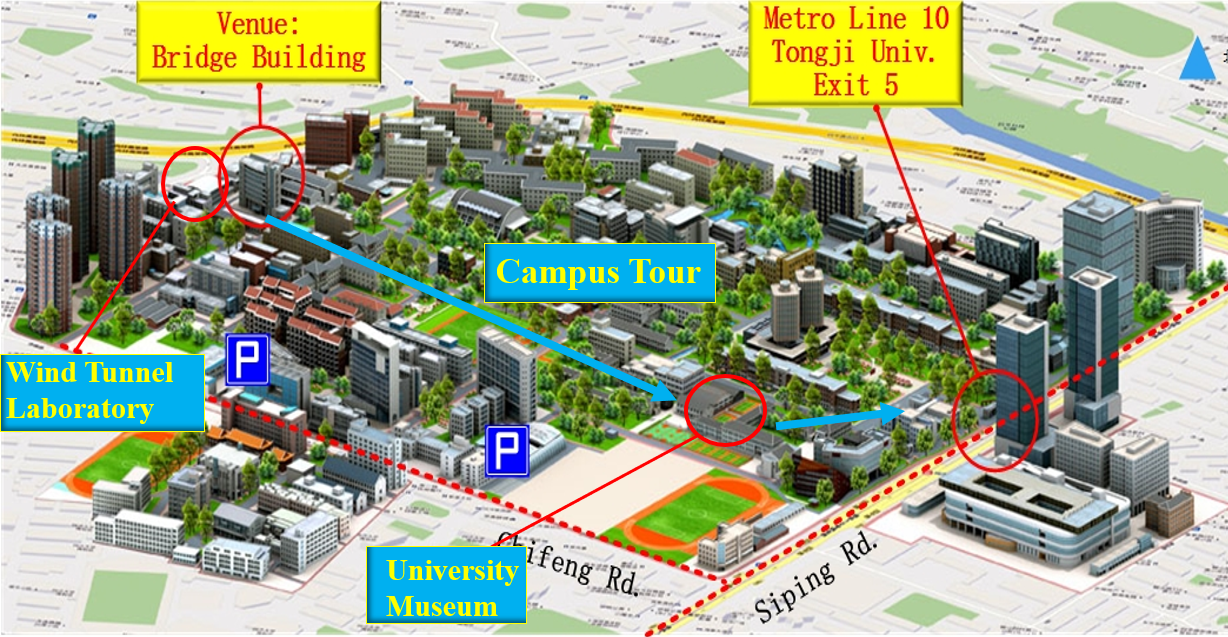
Fig. 2 Technical tour route at campus
[1]. Wind Tunnel Laboratory
The wind tunnel laboratory was built in 1987 and completed in 1990. Tongji University is the earliest Wind Engineering Research Institute in China. At present, the laboratory has six large, medium and small boundary layer wind tunnels, and the overall scale ranks top in the world. The laboratory is equipped with advanced measuring force, pressure, velocity, vibration instruments and data acquisition system and computer workstation for scientific research and production test.
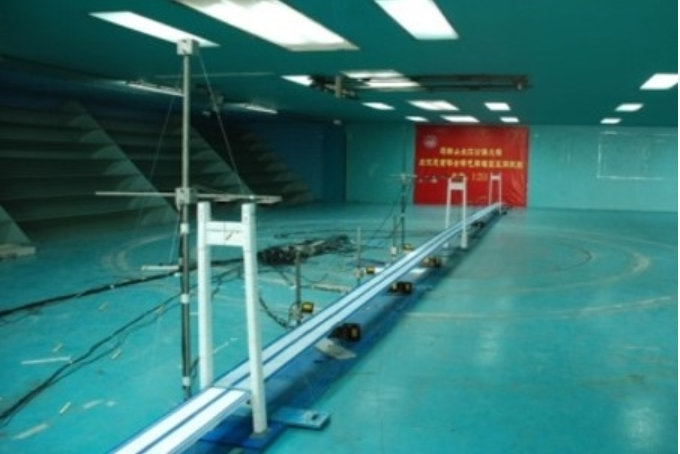
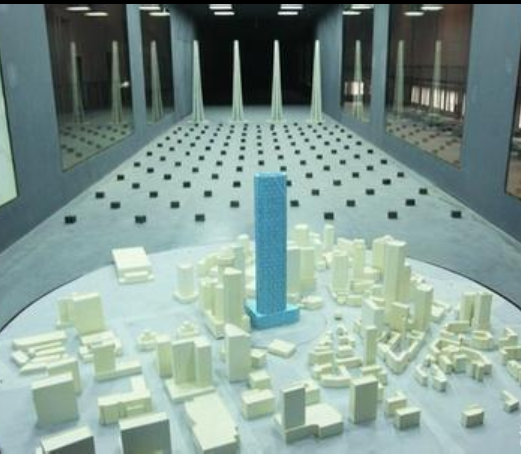
Fig. 3 Wind Tunnel Lab of SLDRCE
[2]. Tongji University Museum
After the 100th anniversary of Tongji University, founded in 1907, the Feasibility Conceptual Design was organized in conjunction with the Graduate Design Program. Ultimately, Tongji campus with the longest history, where the environment has a unique commemorative significance of the 129 building, was selected as the museum site selection and reconstruction of the object. The Museum was established by using the cultural relics and materials collected by Tongji University to serve the scientific research and cultural development of the university.


Fig. 4 Tongji University Museum
[3]. The Bund
The Bund, as one of the most famous places of interest of Shanghai, is 1.5 kilometers long right next to the Central Business District near the Oriental Pearl Radio & TV Tower. It runs from Yan'an East Road in the south to Garden Bridge on Suzhou River in the north. After Shanghai became a commercial port, foreign banks, commercial banks, general associations and newspapers began to gather here, and the Bund became the financial center of the whole country and even the Far East.
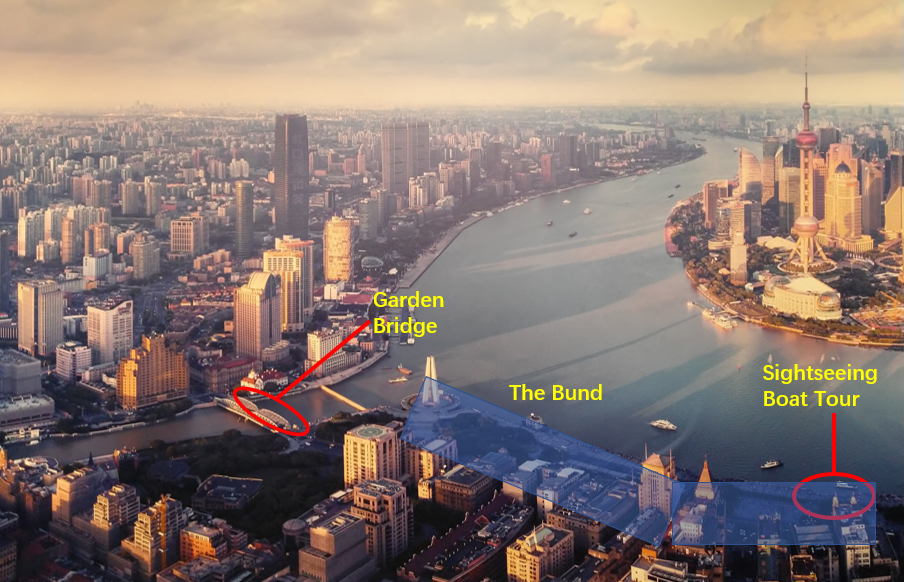
Fig. 5 Technical tour route at the Bund
[4]. Boat Tour
The beautiful scenery on both sides of the Huangpu River is a symbol of Shanghai. On its east side is the prosperous Lujiazui Financial District. On the west side is the historic buildings of all countries. The cruise ship will show you the beautiful scenery in the core area of the Huangpu River.
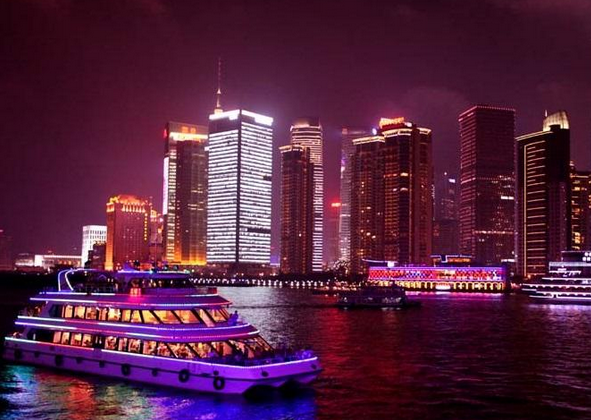
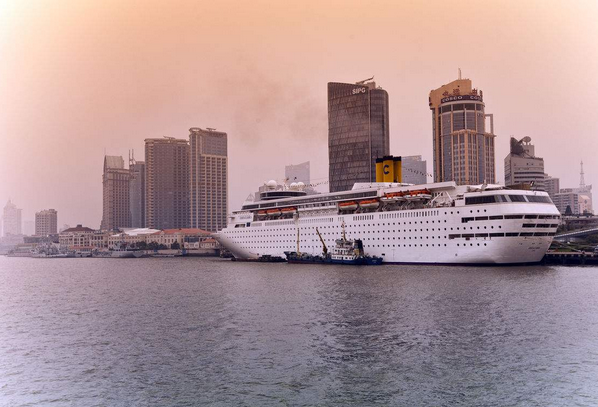
Fig. 6 Sightseeing boat tour
Garden (Waibaidu) bridge: The current Garden bridge, also called Waibaidu Bridge, was built in January 20, 1908. The Garden Bridge was removed as a whole from its site to the factory for repair, and it returned in 2009 with a life extension of 50 years. Because of its rich history and unique design, Garden Bridge has become one of the symbols of Shanghai, and also a symbol of Shanghai's modernization and industrialization.

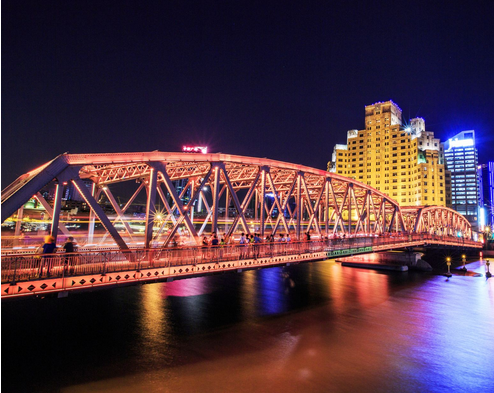
Fig. 7 Garden Bridge (137.25m, built in 1908)
Nanpu Bridge: Nanpu Bridge, built in 1991 and main spanned 423m, is the first bridge across the Huangpu River in downtown Shanghai. The second bridge on the Huangpu River was completed on November 19, 1991. Nanpu Bridge is a cable-stayed bridge with double pylons, double cable planes and composite beams designed and built by China. And it is one of the largest cable-stayed bridges at that time.
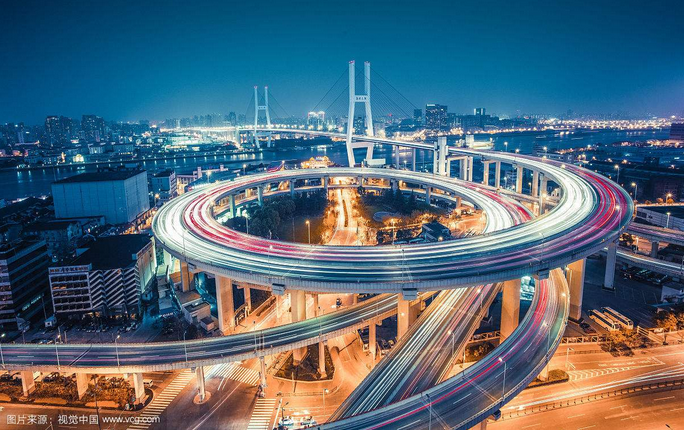
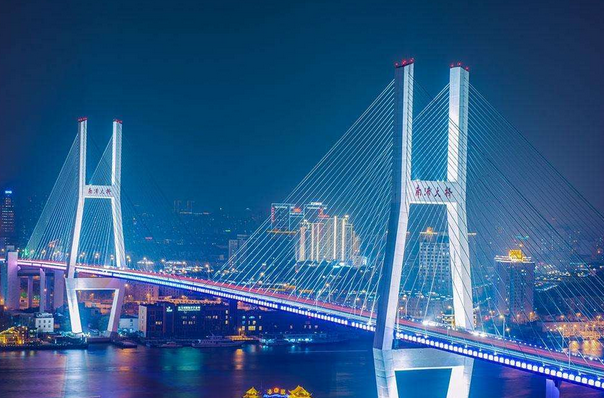
Fig. 8 Huangpu Bridge (423m, built in 1991)
Yangpu Bridge: Yangpu bridge, main spanned 602m, is the second cable-stayed bridge across the Huangpu River. It was the longest cable-stayed bridge in the world when open to traffic in 1993. The Yangpu Bridge with a 208-meter towe is like a sword piercing the sky. 32 pairs of cables on both sides of the tower connect the main girders and spread out in a fan like a giant strings. It is playing the sonata of a giant dragon soaring. The design of the whole bridge is exquisite, beautiful and magnificent. It is a famous sight of Shanghai tourism.
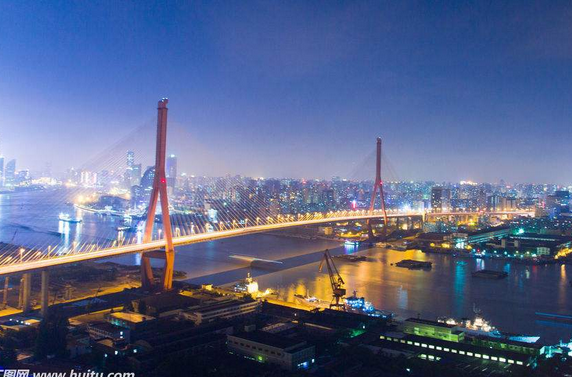
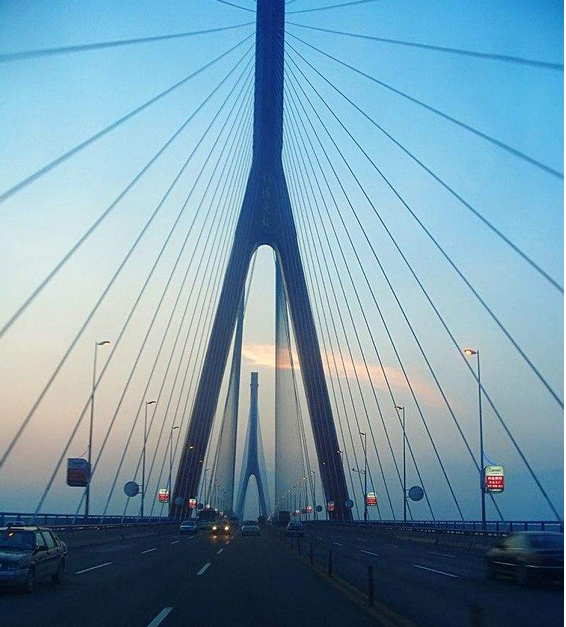
Fig. 9 Yangpu Bridge (602m, built in 1993)
Lupu Bridge: Lupu bridge, built in 2003 and main spanned 550m, is the second longest steel arch bridge in the world today. It is also the first large-scale arch bridge in the world to be entirely welded. It has high scientific and technological content, strict precision requirements and difficult construction. It marks a major breakthrough in Bridge Technology in China, and the level of bridge building has reached a new level. Lupu Bridge is like a beautiful rainbow across the banks of the Pujiang River, adding new landscapes and signs to Shanghai.
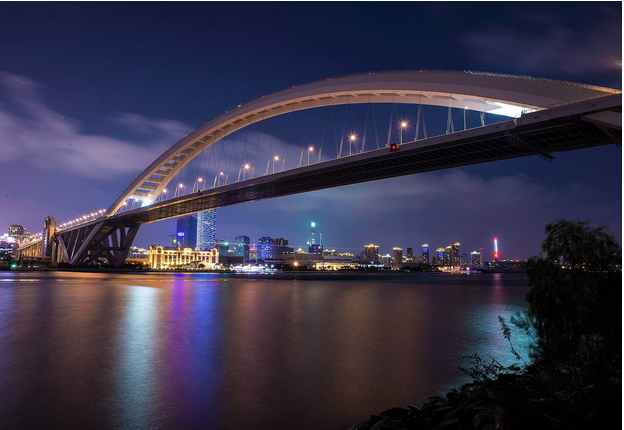
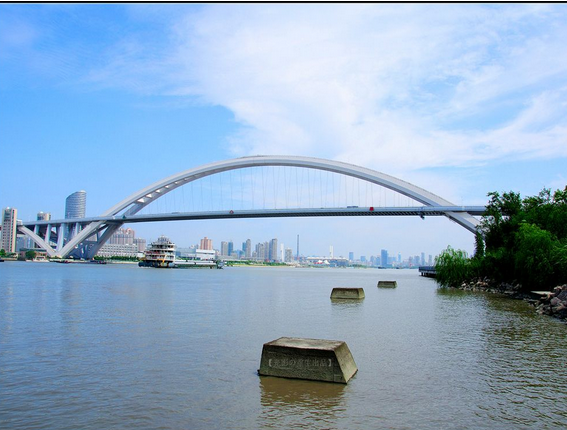
Fig. 10 Lupu Bridge (550m, built in 2003)
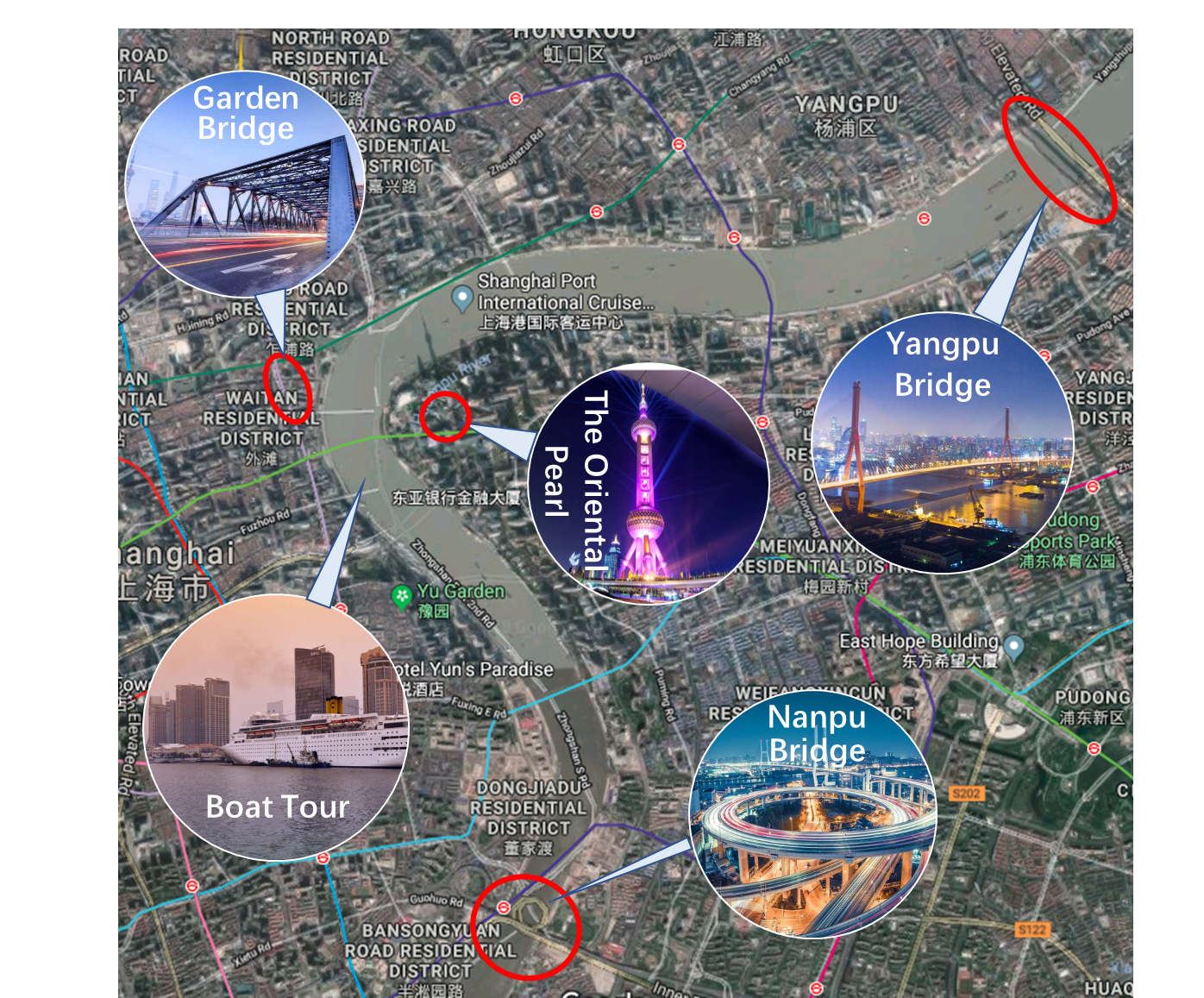
版权所有 桥梁健康监测与振动控制研究室
Email: bridge-shm@tongji.edu.cn
地址:上海市四平路1239号同济大学桥梁馆719室 邮编:200092
